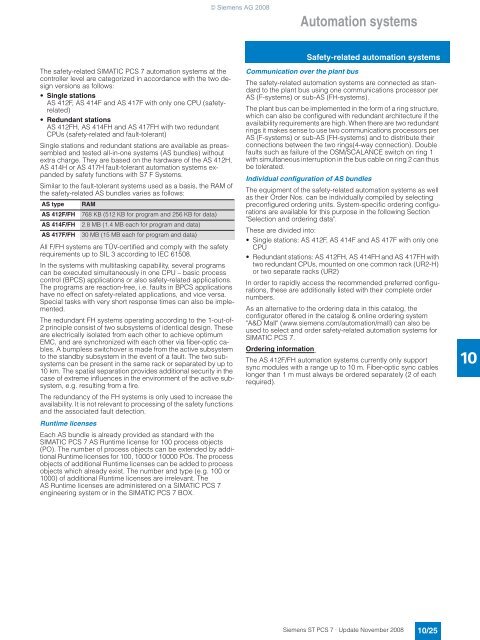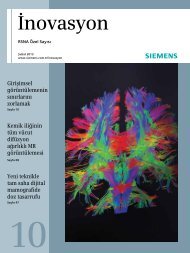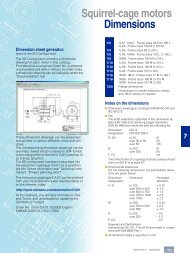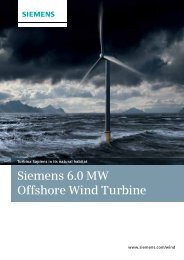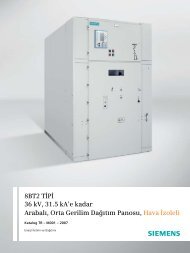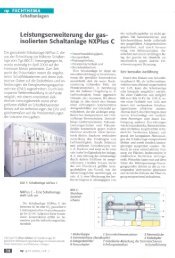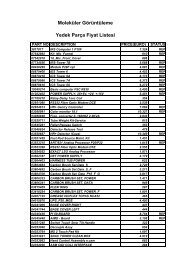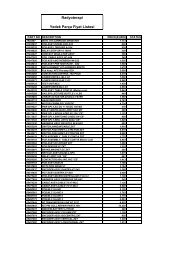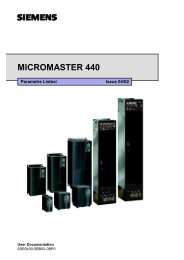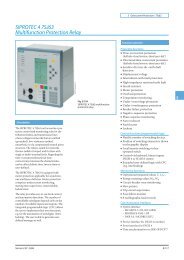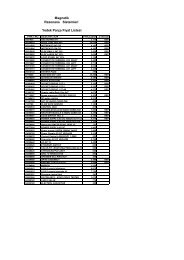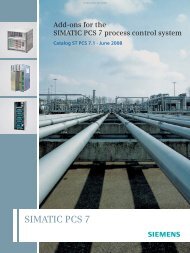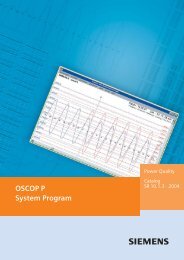SIMATIC PCS 7 Process Control System - Siemens
SIMATIC PCS 7 Process Control System - Siemens
SIMATIC PCS 7 Process Control System - Siemens
Create successful ePaper yourself
Turn your PDF publications into a flip-book with our unique Google optimized e-Paper software.
The safety-related <strong>SIMATIC</strong> <strong>PCS</strong> 7 automation systems at the<br />
controller level are categorized in accordance with the two design<br />
versions as follows:<br />
• Single stations<br />
AS 412F, AS 414F and AS 417F with only one CPU (safetyrelated)<br />
• Redundant stations<br />
AS 412FH, AS 414FH and AS 417FH with two redundant<br />
CPUs (safety-related and fault-tolerant)<br />
Single stations and redundant stations are available as preassembled<br />
and tested all-in-one systems (AS bundles) without<br />
extra charge. They are based on the hardware of the AS 412H,<br />
AS 414H or AS 417H fault-tolerant automation systems expanded<br />
by safety functions with S7 F <strong>System</strong>s.<br />
Similar to the fault-tolerant systems used as a basis, the RAM of<br />
the safety-related AS bundles varies as follows:<br />
AS type RAM<br />
AS 412F/FH 768 KB (512 KB for program and 256 KB for data)<br />
AS 414F/FH 2.8 MB (1.4 MB each for program and data)<br />
AS 417F/FH 30 MB (15 MB each for program and data)<br />
All F/FH systems are TÜV-certified and comply with the safety<br />
requirements up to SIL 3 according to IEC 61508.<br />
In the systems with multitasking capability, several programs<br />
can be executed simultaneously in one CPU – basic process<br />
control (B<strong>PCS</strong>) applications or also safety-related applications.<br />
The programs are reaction-free, i.e. faults in B<strong>PCS</strong> applications<br />
have no effect on safety-related applications, and vice versa.<br />
Special tasks with very short response times can also be implemented.<br />
The redundant FH systems operating according to the 1-out-of-<br />
2 principle consist of two subsystems of identical design. These<br />
are electrically isolated from each other to achieve optimum<br />
EMC, and are synchronized with each other via fiber-optic cables.<br />
A bumpless switchover is made from the active subsystem<br />
to the standby subsystem in the event of a fault. The two subsystems<br />
can be present in the same rack or separated by up to<br />
10 km. The spatial separation provides additional security in the<br />
case of extreme influences in the environment of the active subsystem,<br />
e.g. resulting from a fire.<br />
The redundancy of the FH systems is only used to increase the<br />
availability. It is not relevant to processing of the safety functions<br />
and the associated fault detection.<br />
Runtime licenses<br />
Each AS bundle is already provided as standard with the<br />
<strong>SIMATIC</strong> <strong>PCS</strong> 7 AS Runtime license for 100 process objects<br />
(PO). The number of process objects can be extended by additional<br />
Runtime licenses for 100, 1000 or 10000 POs. The process<br />
objects of additional Runtime licenses can be added to process<br />
objects which already exist. The number and type (e.g. 100 or<br />
1000) of additional Runtime licenses are irrelevant. The<br />
AS Runtime licenses are administered on a <strong>SIMATIC</strong> <strong>PCS</strong> 7<br />
engineering system or in the <strong>SIMATIC</strong> <strong>PCS</strong> 7 BOX.<br />
© <strong>Siemens</strong> AG 2008<br />
Automation systems<br />
Safety-related automation systems<br />
Communication over the plant bus<br />
The safety-related automation systems are connected as standard<br />
to the plant bus using one communications processor per<br />
AS (F-systems) or sub-AS (FH-systems).<br />
The plant bus can be implemented in the form of a ring structure,<br />
which can also be configured with redundant architecture if the<br />
availability requirements are high. When there are two redundant<br />
rings it makes sense to use two communications processors per<br />
AS (F-systems) or sub-AS (FH-systems) and to distribute their<br />
connections between the two rings(4-way connection). Double<br />
faults such as failure of the OSM/SCALANCE switch on ring 1<br />
with simultaneous interruption in the bus cable on ring 2 can thus<br />
be tolerated.<br />
Individual configuration of AS bundles<br />
The equipment of the safety-related automation systems as well<br />
as their Order Nos. can be individually compiled by selecting<br />
preconfigured ordering units. <strong>System</strong>-specific ordering configurations<br />
are available for this purpose in the following Section<br />
"Selection and ordering data".<br />
These are divided into:<br />
• Single stations: AS 412F, AS 414F and AS 417F with only one<br />
CPU<br />
• Redundant stations: AS 412FH, AS 414FH and AS 417FH with<br />
two redundant CPUs, mounted on one common rack (UR2-H)<br />
or two separate racks (UR2)<br />
In order to rapidly access the recommended preferred configurations,<br />
these are additionally listed with their complete order<br />
numbers.<br />
As an alternative to the ordering data in this catalog, the<br />
configurator offered in the catalog & online ordering system<br />
"A&D Mall" (www.siemens.com/automation/mall) can also be<br />
used to select and order safety-related automation systems for<br />
<strong>SIMATIC</strong> <strong>PCS</strong> 7.<br />
Ordering information<br />
The AS 412F/FH automation systems currently only support<br />
sync modules with a range up to 10 m. Fiber-optic sync cables<br />
longer than 1 m must always be ordered separately (2 of each<br />
required).<br />
<strong>Siemens</strong> ST <strong>PCS</strong> 7 · Update November 2008<br />
10/25<br />
10


